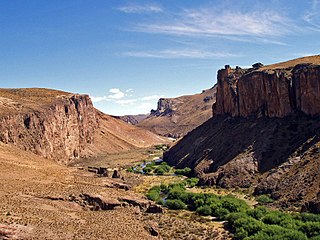Las Manos (arula)
|
Las Manos arula, tir abdiizvugalaf debak tigis koe Santa Cruz winka vagee Argentina. Tamavafa Gadakiewega[betara | va krent betá]Bak 1999 wetce arayaf debak ke tamavafa gadakiewega ke UNESCO zo bendeyer. Ugalopa[betara | va krent betá]Joxara is evlara kan 14-e beba va dzetaf lingeks ke Las Manos arula nedid ba sin tid evlon gu konake sare :
Dulap[betara | va krent betá]Debak va tana losavsafa muxara va abdiizvugalafa yamba koe Geefa Amerika divendir. Arula is cek ko Tamavafa Gadakiewega gan UNESCO zo dakteyed. Aryon debak[betara | va krent betá]Aryon vemaf abdiizvugalaf debak koe Los Toldos is Piedra Museo is El Ceibo koe Santa Cruz winka zo kosmayad, i debak evlon gu 13000 tanda. Drunara[betara | va krent betá]Las Manos arula tir ke enk dem geeamerikaf abdiizvugalaf debak alutas va savsackafa frofara va Amerika, do tulon Monte Verde ( Tcilea ) is Pedra Pintada ( Brasila ).
 Las Manos arula, Río Pinturas (en) The Cueva de las Manos, Río Pinturas, contains an exceptional assemblage of cave art, executed between 13,000 and 9,500 years ago. It takes its name (Cave of the Hands) from the stencilled outlines of human hands in the cave, but there are also many depictions of animals, such as guanacos (Lama guanicoe ), still commonly found in the region, as well as hunting scenes. The people responsible for the paintings may have been the ancestors of the historic hunter-gatherer communities of Patagonia found by European settlers in the 19th century. ~ UNESCO website, licence CC-BY-SA IGO 3.0
Dere rupec[betara | va krent betá]Vuestexa[betara | va krent betá]
|
Teza:ArgentinaUNESCOTamavafaGadakiewega | ||||||||||||||||||||||||||||||||||||||||||||||||||||||||












